Why I am asking this question
I have recently started reading Sicp, and I have worked my way through to Section 1.2.3. I am unable to understand some of the details of Order of Growth. Please bear with me and my overly long question. Please also note that I have never dealt with analyzing algorithms before.
What I read in Sicp and my thoughts about it
Here are few pieces of the text from Sicp:
Which exact value is n ?
Let n be a parameter that measures the size of the problem. In our previous examples we took n to be the number for which a given function is to be computed, but there are other possibilities. For instance, if our goal is to compute an approximation to the square root of a number, we might take n to be the number of digits accuracy required.
Take the following procedure which was given in Section 1.7 for Newton's Method for Square roots:
(define (sqrt x)
(sqrt-iter 1.0 x))
And this is (sqrt-iter)
(define (sqrt-iter guess x)
(if (good-enough? guess x)
guess
(sqrt-iter (improve guess x)
x)))
Where good-enough? checks if the guess a good enough approximations
(define (good-enough? guess x)
(< (abs (- (square guess) x)) 0.001))
Now, according to Sicp, 0.001 should be n, but shouldn't n be input in (sqrt x)?
The number of iterations changes based on input x, that is the number of iterations required
would change based on the size of the number.
Here is my python equivalent proving that:
In [33]: sqrt(2)
1
1.5
1.4166666666666665
achieved 1.4142156862745097 in 3 iterations
In [34]: sqrt(4)
1
2.5
2.05
2.000609756097561
achieved 2.0000000929222947 in 4 iterations
In [35]: sqrt(1024)
1
512.5
257.2490243902439
130.61480157022683
69.22732405448895
42.00958563100827
33.19248741685438
32.02142090500024
achieved 32.0000071648159 in 8 iterations
So shouldn't 0.001 be k1 or k2, as it is a value that is constant and is independent of
n (here the value we input to sqrt)?
Isn't R(n) not constant?
let R(n) be the amount of resources the process requires for a problem of size n. R(n) might measure the number of internal storage registers used, the number of elementary machine operations performed, and so on. In computers that do only a fixed number of operations at a time, the time required will be proportional to the number of elementary machine operations performed.
Here, Sicp says that R(n) might be the number of elementary operations performed, but isn't the number of operations performed be different from OS to OS? As a Linux Machine might do it a certain set of steps, a FreeBSD machine another, and a Windows Machine another? You'll see why I am saying this soon.
Order of Growth
We say that R(n) has order of growth Θ(f (n)), written R(n) = Θ(f (n)) (pronounced “theta of f (n)”), if there are positive constants k1 and k2 independent of n such that k1 f (n) ≤ R(n) ≤ k2 f (n) for any sufficiently large value of n. (In other words, for large n, the value R(n) is sandwiched between k1 f (n) and k2 f (n).)
Now, from what I understand we calculate the growth of the resources used by doing some algebra after
receiving the values from functions R(n) and f(n) (Is R a function? and f what I am thinking of? I don't know!)
The Example with Factorials and the Fibonacci Sequence
For instance, with the linear recursive process for computing factorial described in Section 1.2.1 the number of steps grows proportionally to the input n. Thus, the steps required for this process grows as Θ(n). We also saw that the space required grows as Θ(n). For the iterative factorial, the number of steps is still Θ(n) but the space is Θ(1)—that is, constant. The tree-recursive Fibonacci computation requires Θ(ϕn) steps and space Θ(n), where ϕ is the golden ratio described in Section 1.2.2.
Now this is the part which makes no sense to me - what do I consider a step? Do I consider the number of substitutions using the substitution model? Or do I consider the number of expressions evaluated? Or do I consider when there is arithmetic evaluated?
I understand that the the space is Θ(n) (because the interpreter needs to remember 1 more thing every recursion) in the recursive procedure and in the iterative Θ(1) (as the interpreter the some value with x and continues.) I don't understand how the Fibonacci computation (Tree Recursion) takes Θ(n).
I also have no clue how the earlier n is related with the number of steps.
My Questions
So here is the list of all my questions to do with Order of Growth:
Which exact value in an algorithm is n?
What happens in R(n)? (Assuming its a function of course) Does n divide/multiply a value?
What do I consider a step?
How do I compute the Order of Growth of the steps and space.
In short:
What is Order of Growth, and How do I compute it ?
